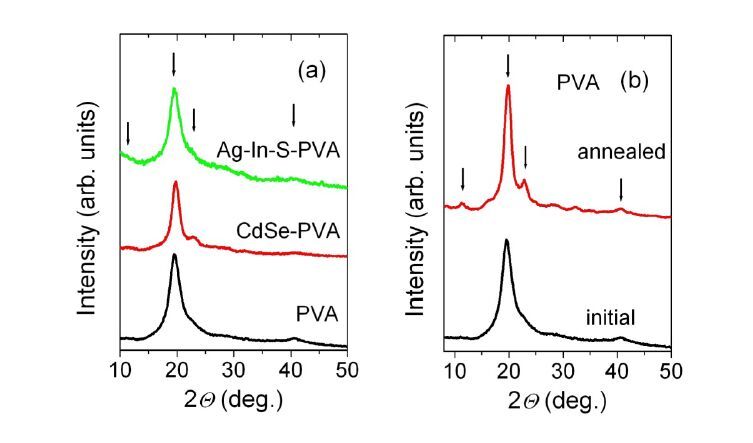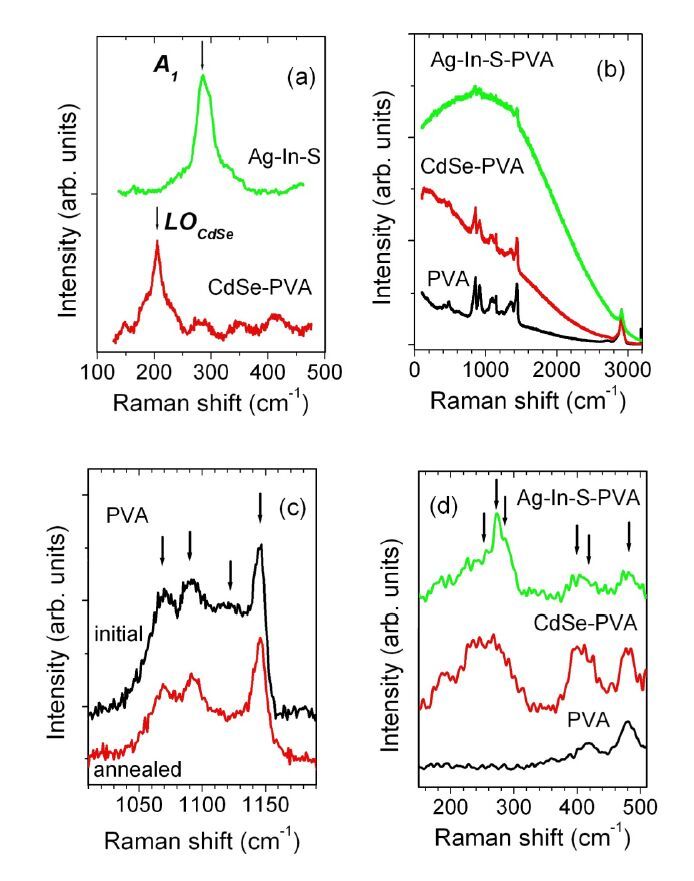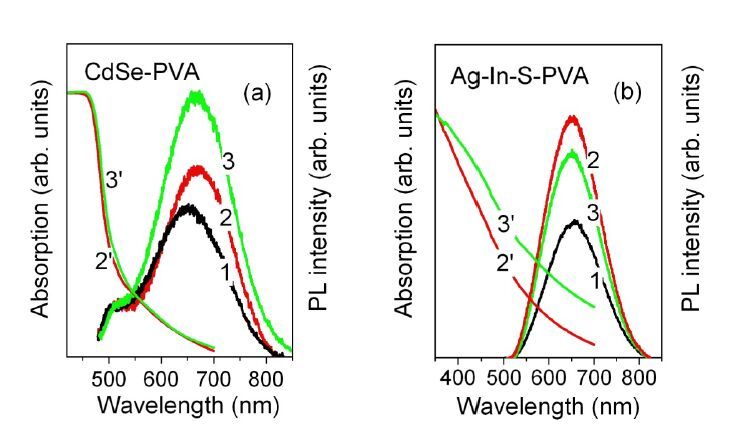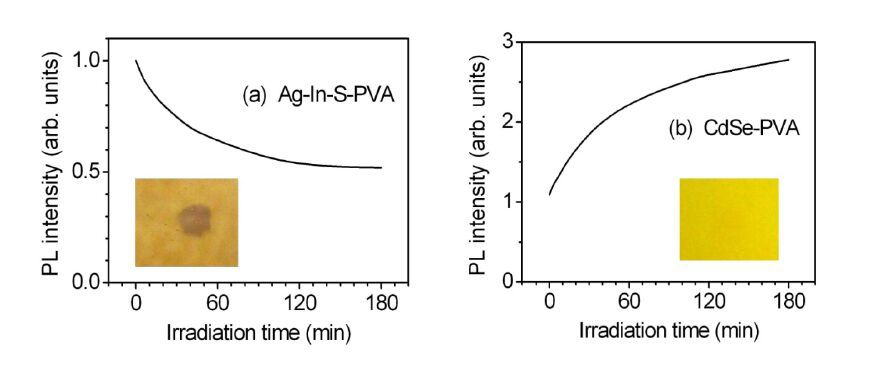The results of investigation of photostability of the composites of CdSe and Ag-In-S nanocrystals (NCs) embedded in the films of polyvinyl alcohol (PVA) are presented. The films were studied by photoluminescence (PL), optical absorption, micro-Raman and X-ray diffraction methods. It is found that heating of the films to 100 °C promotes PVA crystallization and stimulates an increase of the PL intensity for the NCs of both types. The latter effect is ascribed mainly to the improvement of NC surface passivation by functional groups of PVA. The illumination with the 409-nm LED’s light enhances PL intensity for CdSe NCs and decreases it for Ag-In-S NCs as well as results in the darkening of the films. The color of the Ag-In-S-PVA film restores with time, while the change of the optical properties of the CdSe-PVA composite is irreversible. The possible mechanisms of the revealed effects, such as structural transformations at NC/PVA interface as well as the formation of new light-absorbing species are discussed.
1.
Introduction
Stochastic nonlinear control is a hot topic because of its wide application in economic and engineering fields. The pioneer work is [1,2,3,4,5,6,7,8]. Specifically, [1,2,3] propose designs with quadratic Lyapunov functions coupled with weighting functions and [4,5,6,7,8] develop designs with quartic Lyapunov function, which are further developed by [9,10,11,12]. Recently, a class of stochastic systems (SSs) whose Jacobian linearizations may have unstable modes, has received much attention. Such systems are also called stochastic high-order nonlinear systems (SHONSs), which include a class of stochastic benchmark mechanical systems [13] as a special case. In this direction, [14] studies the state-feedback control with stochastic inverse dynamics; [15] develops a stochastic homogeneous domination method, which completely relaxes the order restriction required in [13], and investigates the output-feedback stabilization for SHONSs with unmeasurable states; [16] investigates the output-feedback tracking problem; [17] studies the adaptive state-feedback design for state-constrained systems. It should be emphasized that [13,14,15,16,17], only achieve stabilization in asymptotic sense (as time goes to infinity). However, many real applications appeals for prescribed-time stabilization, which permits the worker to prescribe the convergence times in advance.
For the prescribed-time control, [18,19] design time-varying feedback to solve the regulation problems of normal-form nonlinear systems; [20] considers networked multi-agent systems; [21,22] investigates the prescribed-time design for linear systems in controllable canonical form; [23] designs the output-feedback controller for uncertain nonlinear strict-feedback-like systems. It should be noted that the results in [18,19,20,21,22,23] don't consider stochastic noise. For SSs, [24] is the first paper to address the stochastic nonlinear inverse optimality and prescribed-time stabilization problems; The control effort is further reduced in [25]; Recently, [26] studies the prescribed-time output-feedback for SSs without/with sensor uncertainty. It should be noted that [24,25,26] don't consider SHONSs. From practical applications, it is important to solves the prescribed-time control problem of SHONSs since it permits the worker to set the convergence times in advance.
Motivated by the above discussions, this paper studies the prescribed-time design for SSs with high-order structure. The contributions include:
1) This paper proposes new prescribed-time design for SHONSs. Since Jacobian linearizations of such a system possibly have unstable modes, all the prescribed-time designs in [24,25,26] are invalid. New design and analysis tools should be developed.
2) This paper develops a more practical design than those in [13,14,15,16,17]. Different from the designs in [13,14,15,16,17] where only asymptotic stabilization can be achieved, the design in this paper can guarantee that the closed-loop system is prescribed-time mean-square stable, which is superior to those in [13,14,15,16,17] since it permits the worker to prescribe the convergence times in advance without considering the initial conditions.
The remainder of this paper is organized as follows. In Section 2, the problem is formulated. In Section 3, the controller is designed and the stability analysis is given. Section 4 uses an example to explain the validity of the prescribed-time design. The conclusions are collected in Section 6.
2.
Problem formulation
Consider the following class of SHONSs
where $ x = (x_{1}, x_{2})^{T} \in R^{2} $ and $ u \in R $ are the system state and control input. $ p\geq1 $ is an odd integral number. The functions $ \varphi_{i}: R^{2}\rightarrow R^{m} $ are smooth in $ x $ with $ \varphi_{i}(0) = 0 $, $ i = 1, 2 $. $ \omega $ is an $ m $-dimensional independent standard Wiener process.
The assumptions we need are as follows.
Assumption 1. There is a constant $ c > 0 $ such that
We introduce the function:
where $ m\geq 2 $ is an integral number. Obviously, the function $ \mu(t) $ is monotonically increasing on $ [t_{0}, t_{0}+T) $ with $ \mu(t_{0}) = 1 $ and $ \lim\limits_{t\rightarrow t_{0}+T}\mu(t) = +\infty $.
Our control goal is to design a prescribed-time state-feedback controller, which guarantees that the closed-loop system has an almost surely unique strong solution and is prescribed-time mean-square stable.
3.
Controller design and stability analysis
In the following, we design a time-varying controller for system (2.1)–(2.2) step by step.
Step 1. In this step, our goal is to design the virtual controller $ x_{2}^{*} $.
Define $ V_{1} = \frac{1}{4}\xi_{1}^{4} $, $ \xi_{1} = x_{1} $, from (2.1), (2.3) and (2.5) we have
Choosing
which substitutes into (3.1) yields
where $ \alpha_{1} = (2+\frac{3}{2}c^{2})^{1/p} $.
Step 2. In this step, our goal is to design the actual controller $ u $.
Define $ \xi_{2} = x_{k}-x_{2}^{*} $, from (3.2) we get
By using (2.1)–(2.2) and (3.4) we get
We choose the following Lyapunov function
It follows from (3.3), (3.5)–(3.6) that
By using (3.4) we have
where
By using Young's inequality we get
and
Substituting (3.10)–(3.11) into (3.8) yields
From (2.3), (2.4), (3.2) and (3.4) we have
where
By using (3.13) we get
It can be inferred from (3.7), (3.12) and (3.15) that
where
We choose the controller
then we get
Now, we describe the main stability analysis results for system (2.1)–(2.2).
Theorem 1. For the plant (2.1)–(2.2), if Assumption 1 holds, with the controller (3.18), the following conclusions are held.
1) The plant has an almost surely unique strong solution on $ [t_{0}, t_{0}+T) $;
2) The equilibrium at the origin of the plant is prescribed-time mean-square stable with $ \lim\limits_{t\rightarrow t_{0}+T} E|x|^{2} = 0 $.
Proof. By using Young's inequality we get
where
It can be inferred from (3.19)–(3.21) that
From (2.1), (2.2) and (3.18), the local Lipschitz condition is satisfied by the plant. By (3.23) and using Lemma 1 in [24], the plant has an almost surely unique strong solution on $ [t_{0}, t_{0}+T) $, which shows that conclusion 1) is true.
Next, we verify conclusion 2).
For each positive integer $ k $, the first exit time is defined as
Choosing
From (3.23) and (3.25) we have
By (3.26) and using Dynkin's formula we get
Using Fatou Lemma, from (3.27) we have
By using (3.25) and (3.28) we get
By using (3.6) and (3.29) we obtain
4.
A simulation example
Consider the prescribed-time stabilization for the following system
where $ p_{1} = 3 $, $ p_{2} = 1 $. Noting $ 0.2x_1x_2\leq 0.1(x_{1}^{2}+x_{2}^{2}) $, Assumption 1 is satisfied.
Choosing
According to the design method in Section 3, we have
In the practical simulation, we select the initial conditions as $ x_{1}(0) = -6 $, $ x_{2}(0) = 5 $. Figure 1 shows the responses of (4.1)–(4.4), from which we can obtain that $ \lim\limits_{t\rightarrow t_{0}+T} E|x_{1}|^{2} = \lim\limits_{t\rightarrow t_{0}+T} E|x_{2}|^{2} = 0 $, which means that the controller we designed is effective.
5.
Concluding remarks
This paper proposes a new design method of prescribed-time state-feedback for SHONSs. the controller we designed can guarantee that the closed-loop system has an almost surely unique strong solution and the equilibrium at the origin of the closed-loop system is prescribed-time mean-square stable. The results in this paper are more practical than those in [13,14,15,16,17] since the design in this paper permits the worker to prescribe the convergence times in advance without considering the initial conditions.
There are some related problems to investigate, e.g., how to extend the results to multi-agent systems [27], impulsive systems [28,29,30] or more general high-order systems [31,32,33,34].
Acknowledgments
This work is funded by Shandong Provincial Natural Science Foundation for Distinguished Young Scholars, China (No. ZR2019JQ22), and Shandong Province Higher Educational Excellent Youth Innovation team, China (No. 2019KJN017).
Conflict of interest
The authors declare there is no conflict of interest.
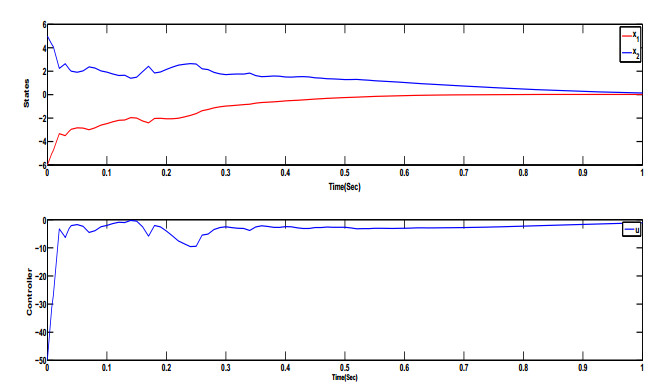









 DownLoad:
DownLoad:


